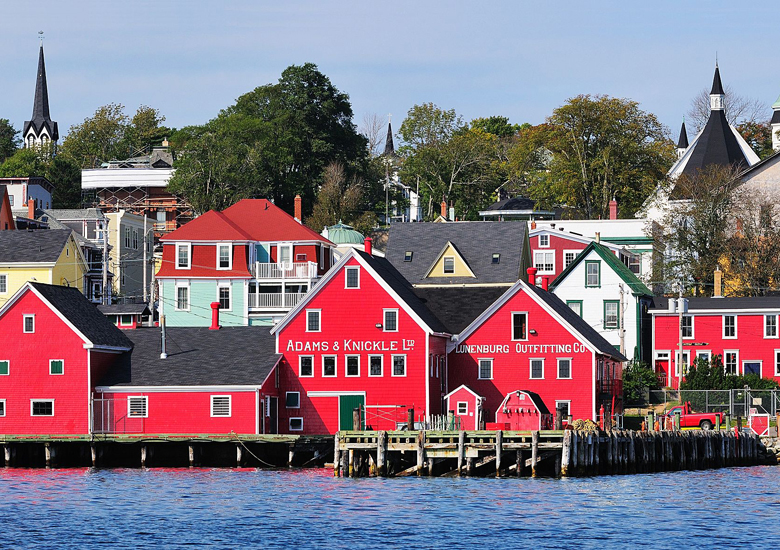Lunenburg is a port town in Lunenburg County, Nova Scotia, Canada. Situated on the province’s South Shore, Lunenburg is located on the Fairhaven Peninsula at the western side of Mahone Bay. The town is approximately 90 kilometres southwest of the county boundary with the Halifax Regional Municipality. The town was established by the four founding fathers, Patrick Sutherland, Dettlieb Christopher Jessen, John Creighton and Jean-Baptiste Moreau during Father Le Loutre’s War, four years after Halifax was established. The town was one of the first British attempts to settle Protestants in Nova Scotia intended to displace Mi’kmaq and Acadian Catholics. British settlement posed a lasting, grave and certain threat to Mi’kmaq’s control over their traditional territorial borders of Mi’kma’ki within Wabanaki. Considering that British conditions for peace required surrender of Mi’kmaq sovereignty to the Crown, Wabanaki groups raided Lunenburg nine times in the early years of the settlement in an attempt to reclaim their loss.
The historic town was designated a United Nations Educational, Scientific and Cultural Organization (UNESCO) World Heritage Site in 1995. This designation ensures protection for much of Lunenburg’s unique architecture and civic design, being the best example of planned British colonial settlement in Canada. The historic core of the town is also a National Historic Site of Canada.
Access : Coordinates: 44.383333, -64.316667 / By car : From Halifax, get on Highway 102 North (Bayers Rd.), then take Exit 1A toward Highway 3/Highway 333/Peggy’s Cove/South Shore/Yarmouth. Merge onto Highway 103 West, then get off at Exit 11 (Highway 324.) Turn left on the 324 (Cornwall Rd.) for Lunenburg. For a longer, more scenic drive, take the Lighthouse Route (Highway 3), which goes along the coast and directly through Lunenburg. From Yarmouth, take Highway 103 E to Exit 11. By bus : Trius Tours operates a daily bus service between the Halifax Via Rail station (6040 Almon St.) and Mike’s Kwik-Way in Lunenburg.
Get around : There is no public transportation in Lunenburg, but it is small enough to be explored on foot. Trot in Time, located outside the Fisheries Museum, gives tours of the town in horse-drawn buggies from May to October. Lunenburg Town Walking Tours run by local historian, Eric Croft, provide a look at the town’s history as you walk through it.
Attractions :
1 ) Bluenose II. A replica of the original Bluenose featured on the flipside of Canadian dimes, spends much of the season in Lunenburg, where she was built. When she’s in port, two-hour morning and afternoon cruises are available.
2 ) The Fisheries Museum of the Atlantic commemorates Atlantic Canada’s fishing tradition with exhibits that include the schooner Theresa E. Connor, an aquarium featuring native species, a working boat building shop, and the steel-hulled side trawler Cape Sable. Guided tours are available in the summer season.
3 ) Lunenburg Academy. Built 1894-95, Lunenburg Academy has been designated a Provincial Heritage Property
4 ) Sophie McLachlan’s grave, Kaulbach Street. In 1879, fourteen-year-old Sophie McLachlan was accused of stealing $10 from her employer, a significant amount of money at the time. Everyone, including Sophie’s own mother believed her accuser. Sophie suffered from increasingly debilitating bouts of anxiety. She always maintained her innocence, and at the end managed to write a letter citing Biblical passages relating to unjust persecution and forgiveness, and stating that she did forgive her accusers. Officially, she died of “a paralyzed heart brought on by extreme agitation and peculiar circumstances” A few months later, due to public interest and the high profile nature of her death, the son of her accusing employer confessed to the theft. Her grave now lies in a pleasant cemetery next to the Lunenburg Academy. There is a marker telling her story along with a wrought iron heart being pulled in two by the chains attaching it to the short fence surrounding her plot.
5) Blue Rocks : Blue Rocks is known as one of the best kayaking spots on the South Shore of Nova Scotia.

